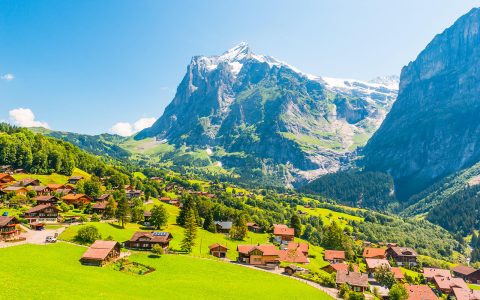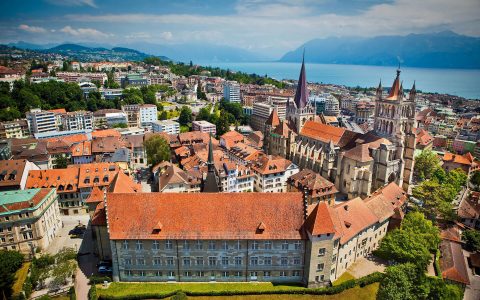In Deep: Lugano, Switzerland
 Don’t let its location on the Swiss side of the border fool you: Lugano lends its name to both a fashionable town and charming lake in Italy’s Lake District, and the region bears the hallmarks of both its Swiss heritage and its Italian proximity.
Don’t let its location on the Swiss side of the border fool you: Lugano lends its name to both a fashionable town and charming lake in Italy’s Lake District, and the region bears the hallmarks of both its Swiss heritage and its Italian proximity.
“Free and Swiss”
(But Chic and Italian Nonetheless)
This fashionable city with 40,000 inhabitants rests in the Swiss canton of Ticino. Lugano graces the lakeshore with its tree-lined promenade, stately hotels, banks and office buildings, while high above, Mount San Salvatore and Mount Brè flank the city and provide stunning wooded backdrops that cradle charming mountaintop villages. Taken from Milan by the Swiss in 1512, it was ruled as a subject district until the dissolution of the old Swiss Confederation in 1798.

Choosing to remain “free and Swiss,” the inhabitants vigorously refused any overtures to be brought under Italian domination. In 1803, the town became part of the new canton of Ticino. Later, between 1848 and 1866, it lent support to the Italian unification movement, acting as the headquarters for Giuseppe Mazzini’s ardent anti-monarchist campaign in the struggle to throw off the Austrian yoke in Lombardy.
Today, Lugano has benefited from Swiss neutrality, standing out as one of the major commercial and banking centres within Switzerland, while continuing to show off its culturally Italian pizzazz.

Parco Civico
This tranquil lakeside park was once the private residence of the Ciani family. The villa grounds maintain a wide selection of outdoor modern sculpture, and offer many quiet paths along the shoreline for a romantic evening passeggiata.
The villa itself is now the Municipal Art Museum of Lugano, housing great Impressionist paintings as well as the works of the most important Ticino artists from all periods.
Santa Maria degli Angioli
The stoic church of Santa Maria degli Angioli is not Lugano’s oldest church, but is its most famous. Built in 1510 by the Franciscans, it is enriched by the finest Renaissance frescoes in the Ticino. The church contains Bernardino Luini’s luminous version of Christ’s Passion, frescoed in 1529, which covers the tall partition dividing the choir and nave.
Experience Switzerland With B&R
Scheduled Group Walking Trip
On our scheduled Italian Lakes Walking trip, truly incredible walks lead us through the charming streets of Lugano and über-chic Bellagio to unforgettable authentic meals at opulent waterfront resorts.
DETAILED ITINERARYPrivate Walking Trip
Go private on this Italian Lakes Walking trip, making your way through sublime mountain scenery, travel along the glamorous lakefront by private boat, and stay in star-studded villas along the way.
DETAILED ITINERARYLake Lugano
The smallest of the three lakes (and the most politically confusing), Lake Lugano zigzags 35 kilometres (22 miles) through the Swiss canton of Ticino, and reaches back into Italy with its eastern extension. Along the way, it passes by the enigmatic, self-contained Italian enclave of Campione d’Italia, just south of the city of Lugano (more on that below).

The emerald-green sub-alpine lake was created by glaciers during the last Ice Age, and reaches the astounding depth of 279 metres (915 feet). The steep, fjord-shores, which are considerably less developed than both Italian lakes, enhance its natural setting, giving it an austere intimacy that is typically Swiss.
 Campione d’Italia
Campione d’Italia
Campione d’Italia, literally a “Sample of Italy,” is a small Italian enclave located on the southern shore of the lake, but entirely in Switzerland.
Bequeathed to the church in 777 by its Lombard owner, Totone, Campione remained loyal to the church for centuries. In fact, Campione was famous for its master builders, Maestri Campionesi, who had a hand in constructing most of Italy’s Romanesque cathedrals. Campione has remained part of Italy since 1797, when Napoleon passed through, bringing it into the Kingdom of Italy.
Although Campione is still an Italian enclave today, it belongs to Switzerland in terms of customs, economy and currency (told you it was politically confusing…). These days, Campione d’Italia is more famous for its casinos, with the profits going to support public works in the province of Como.
Morcote
Morcote lies in the Swiss canton of Ticino on the shore of Lake Lugano. This peaceful little lakeside village sits at the bottom of Monte San Salvatore and has only about 1,000 permanent inhabitants.
Morcote is historically significant due to its strategic position on Lake Lugano. As early as the 12th century it had privileges to impose taxes on trade, control the fishing industry and hold markets. In fact, it was the lake’s largest port until the dam in nearby Melide was built in 1847.
As with many of the towns along the lake, tourism became the main industry in the late 19th century and remains so today. The Scherrer Gardens, the former home of wealthy St. Gallen textile merchant, is one of the top attractions, and has been since 1965 when it was left to the Morcote Municipality.
Arturo Scherrer was a keen traveller and a lover of art who collected objects from around the world and even replicated sites that inspired him. The gardens are rich with luxurious subtropical vegetation along with his art collection, which you can see in this video from Morcote’s tourism board:
Gandria
Located at the foot of Mount Brè, Gandria sits perched on the edge of Lake Lugano. This picturesque fishing village hosts a myriad of stepped streets and sleepy houses. Its charming qualities are much appreciated by artists and tourists today. Opposite Gandria on the far side of the lake is the Gandria Customs House, now a museum where devices once used by smugglers are exhibited.
MORE FROM Europe + Switzerland

Notes From the Road: Swiss E-Biking
Switzerland
Top 5 Driving Routes in Germany, Austria & Switzerland
Austria
15 Ways to Experience the Culture, History & Natural Treasure of Lausanne
Switzerland
Insider’s Guide: 8 Things to Do in Geneva
Switzerland
Switzerland E-Biking Named Tour of a Lifetime
Switzerland

